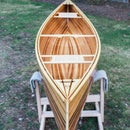Introduction: Building a Cedar Strip Canoe in My Garage
I posted an Instructable a couple months ago for the first canoe I built. I just finished my second canoe and wanted to share the full video series I made for it. This first video is a montage of the entire 8-month process from start to finish. The subsequent steps provide instruction for every process. Feel free to check out my Instagram and YouTube Channel for more of my "stuff"! Thanks for looking!
Step 1: What to Know Before You Build...
Cedar Strip Canoes are beautiful, lightweight, very strong boats. They're a fun project and they're not as hard to build as they look! Anyone looking for a long term woodworking project should consider building one!
In this video, I talk about the big things to consider before you start building.
Step 2: Setting Up the Mold
In this video I explain how I set up my mold for the canoe. The mold is kind of like a big plywood skeleton that you wrap the cedar strips onto to make the shape of the canoe.
Step 3: Making the Stems
In this video I explain how I make my inner and outer stems for a cedar strip canoe. The stems are the hardwood ends of the canoe where the strips meet. I bend a bunch of ash strips by soaking the in a bathtub, then laminate them together. The relationship between the inner and outer stem confused me when I was reading online about how they work together. Hopefully this video helps it make sense!
Step 4: Milling the Strips
In this video I explain how I mill my strips for a cedar strip canoe. I cut my strips from some really nice clear WRC I found on craigslist.
To mill the strips I cut my boards at ¾”, rip each of of those to just over ¼” strips, run all the strips through a planer and exactly ¼” so they would be the same size, route a “bead and cove" pattern onto the edges of each strip so they fit snuggly together around the curves of the hull.
Step 5: Making a Decorative Pattern
I made a pattern on the side of the boat. Had to follow some weird steps - this video shows how I did it.
Step 6: Building the Hull (Part 1)
In this video I explain how I mount the strips onto the mold to build the hull. I am using a method that does not require staples. Basically, you glue the strips together around the mold - fitting each strip into the next strip using their corresponding bead and cove edges.
Step 7: Building the Hull (Part 2)
In this video I show how I finish building the hull. I work the two sides of the boat towards each other until the hull is closed. Now it looks canoe shaped!
Step 8: Attaching the Outer Stems
In the "making the stems" video I glued the 3 inner strips together to make the "inner stem" and the three outer strips together to make the "outer stem". I build the hull onto the inner stem then I carve out a space to attach the outer stem. Again, this is kind of complicated, but the video should help people understand.
Step 9: Prepping the Hull to Fiberglass
Lots and lots of sanding...
Step 10: Applying a Fiberglass/epoxy Seal (outside of the Hull)
In this video I explain how I apply a fiberglass epoxy seal to the outside of my cedar strip canoe. This is one of the most exciting parts of the building process but it’s also the most stressful and scary. There are so many variables that can affect how the epoxy cures (mixing ratios, temperature, timing, application technique, dust, unknown factors, etc.). You have to apply 4 coats in one day so I started at 5am and finished around 8pm. This is the only video I made that was filmed in a single day.
Step 11: Applying a Fiberglass/epoxy Seal (inside of the Hull)
In this video I show how I sand the epoxy, flip the boat, and fiberglass the inside.
This seal makes the boats extremely strong and water proof.
Step 12: Making the Gunnels
The gunnels are the hardwood rails that go around the rim of the canoe. In this video I show how I make the inner and outer gunnels.
Step 13: Installing the Gunnels
In this video I attach the gunnels and the decks to the hull.
Step 14: Making a Yoke
The yoke gives the canoe some structural stability, let's you carry the boat on your back, and it looks cool. In this video I show the process for shaping and installing it.
Step 15: Making the Seats
Making the seats is fairly easy. In this video I show how I make them and my process for placing and installing them.
Step 16: Weaving Cane Seats
I wove cane for the seats...
Step 17: Finding a Good Place to Varnish
My wife was kind enough to give up our bedroom for a month so I could varnish in a dust free & warm environment.
Step 18: Applying the Varnish
The final step is applying varnish. You have to varnish over the epoxy because epoxy doesn't have good UV protection. I broke the canoe into three sections and applied four coats to each section. You have to wait 24 hours between coats so the whole process took about a month.
Step 19: Putting It in the Water
It floats! The whole process took 8 months. Filming made the building process much longer and more difficult. Thanks for checking it out! I'm going to do a guitar building series next Fall - If you're interested in that, don't forget to subscribe to my YouTube Channel!













